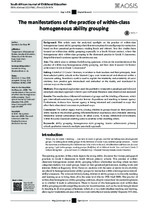| dc.contributor.author | Du Plooy, Lucinda L. | |
| dc.date.accessioned | 2021-11-02T14:06:54Z | |
| dc.date.available | 2021-11-02T14:06:54Z | |
| dc.date.issued | 2019 | |
| dc.identifier.citation | Du Plooy, L.L. (2019). The manifestations of the practice of within-class homogeneous ability grouping. South African Journal of Childhood Education, 9(1), a690. https://doi.org/10.4102/ sajce.v9i1.690 | en_US |
| dc.identifier.issn | 2223-7682 | |
| dc.identifier.uri | https://doi.org/10.4102/ sajce.v9i1.690 | |
| dc.identifier.uri | http://hdl.handle.net/10566/6984 | |
| dc.description.abstract | This article casts the analytical spotlight on the practice of within-class
homogeneous (same) ability grouping where learners are placed in small groups for instruction
based on their perceived performances, reading levels and interest. Very few studies have
focused on within-class ability grouping, especially in a South African context, where this
homogeneous style within-class grouping is the dominant practice in Grade 1 classrooms,
despite literature’s cautions against its continuous use.This article aims to address the following questions: what are the manifestations of the
practice of within-class homogeneous ability grouping, and how does it account for learner
achievement levels in Grade 1 classrooms?. | en_US |
| dc.language.iso | en | en_US |
| dc.publisher | AOSIS | en_US |
| dc.subject | Ability grouping | en_US |
| dc.subject | Learner achievement | en_US |
| dc.subject | Primary school | en_US |
| dc.subject | South Africa | en_US |
| dc.subject | Homogeneous style grouping | en_US |
| dc.title | The manifestations of the practice of within-class homogeneous ability grouping | en_US |
| dc.type | Article | en_US |

